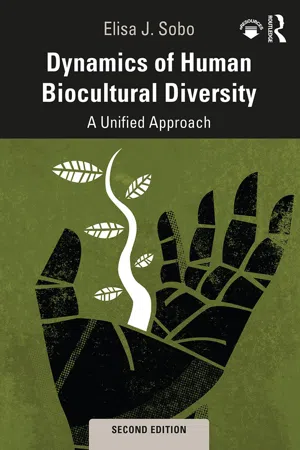
- 292 pages
- English
- ePUB (mobile friendly)
- Available on iOS & Android
About this book
This lively text by leading medical anthropologist Elisa J. Sobo offers a unique, holistic approach to human diversity and rises to the challenge of truly integrating biology and culture. The inviting writing style and fascinating examples make important ideas from complexity theory and epigenetics accessible to students. In this second edition, the material has been updated to reflect changes in both the scientific and socio-cultural landscape, for example in relation to topics such as the microbiome and transgender. Readers learn to conceptualize human biology and culture concurrently—as an adaptive biocultural capacity that has helped to produce the rich range of human diversity seen today. With clearly structured topics, an extensive glossary and suggestions for further reading, this text makes a complex, interdisciplinary topic a joy to teach. Instructor resources include an extensive test bank and a study guide.
Frequently asked questions
- Essential is ideal for learners and professionals who enjoy exploring a wide range of subjects. Access the Essential Library with 800,000+ trusted titles and best-sellers across business, personal growth, and the humanities. Includes unlimited reading time and Standard Read Aloud voice.
- Complete: Perfect for advanced learners and researchers needing full, unrestricted access. Unlock 1.4M+ books across hundreds of subjects, including academic and specialized titles. The Complete Plan also includes advanced features like Premium Read Aloud and Research Assistant.
Please note we cannot support devices running on iOS 13 and Android 7 or earlier. Learn more about using the app.
Information
Part I
A Systems View of Human Adaptation
Chapter by Chapter Overview
Central Lessons of Part I
1
Anthropology and Complexity
- Define biological determinism, discuss its shortcomings, and explain what people hope to accomplish when using it
- Describe anthropology with reference to holism (in contrast to reductionism) and the comparative method
- Define and differentiate ecosystems and complex adaptive systems, paying special attention to the concept of adaptation and the phenomenon of emergence
- Demonstrate how human groups may be studied as (and as part of larger) complex adaptive systems, focusing on adaptation and emergence
Where Did the Nature–Nurture Question Come From?
Biological versus Cultural Determinism

Nature and Nurture Work Together
Table of contents
- Cover
- Endorsements
- Half-Title
- Title
- Copyright
- Contents
- List of Figures
- List of Tables
- List of Supplemental Case Materials
- Author
- Preface to the Second Edition
- Preface to the First Edition
- Acknowledgments
- PART I A SYSTEMS VIEW OF HUMAN ADAPTATION
- PART II SOCIO-POLITICAL AND ECONOMIC FACTORS
- PART III MEANINGFUL PRACTICES
- Glossary
- References
- Index